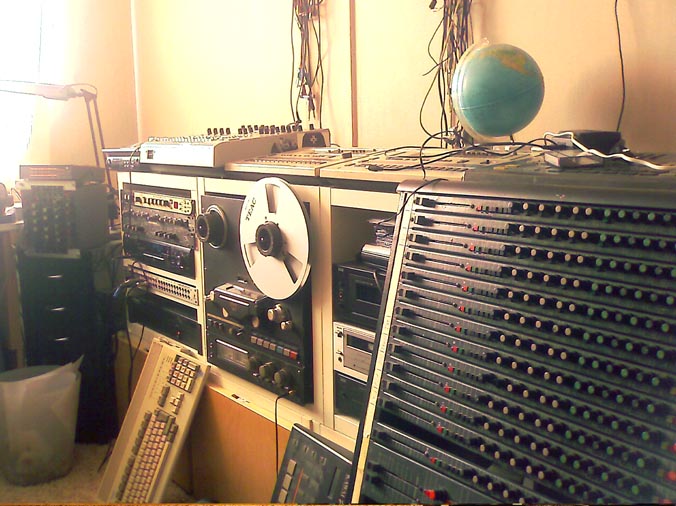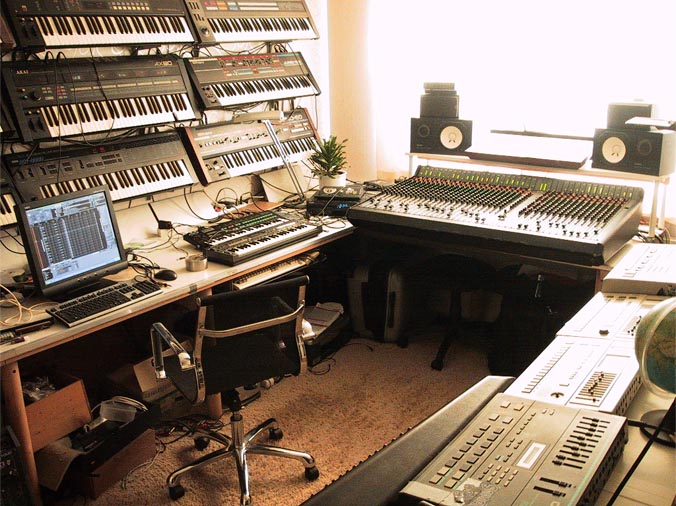
Synthesizers:
Akai AX 60
• An interesting 2 VCO synthesizer, very versatile but especially
great for 8 bit sounding patches. Akai originally intended it to compete
with the Juno 106, but I feel it’s far better then just a Juno clone,
and it sounds rather different. Fun addition is that it has a filter input,
originally designed to use with older akai samplers, making use of a 16(?)
pin DIN cable. It comes with a far better interface than the AX-73, but
it does make me rather curious of the AX-80. So erm... if you are selling
one, you do know where to find me! Edit: my dear friend Legowelt knew where
to find me and is sold me his!
Sound example: Akai AX60 (arpeggio's and melodie), Siel DK80 bassline and sampled CR78
Akai AX 80
• I don't think I will reach the point where I'll say I like it
better than the AX60. They're different. The AX80 sounds richer but the
AX60 is a better overall synth. Especially in the lower tone regions the
AX80 has a lot more character, but when you move up it doesn't stay as strong,
whilst the AX60 keeps a lot of it's strenght in all regions, but can't compete
on the lower range.
The interface is different from the slider-interface of the AX60, but it
is actually almost as easy to use. Instead of a slider for each function,
the AX80 has a pushbutton for each function: push the button and control
the parameter with the data wheel. It really does feel like a analog interface,
unlike for instance the Roland JX-8P.
Sound example: Akai AX80 (3 times multi tracked in accoustica internet audio mix)
Casio CZ 101 (2x)
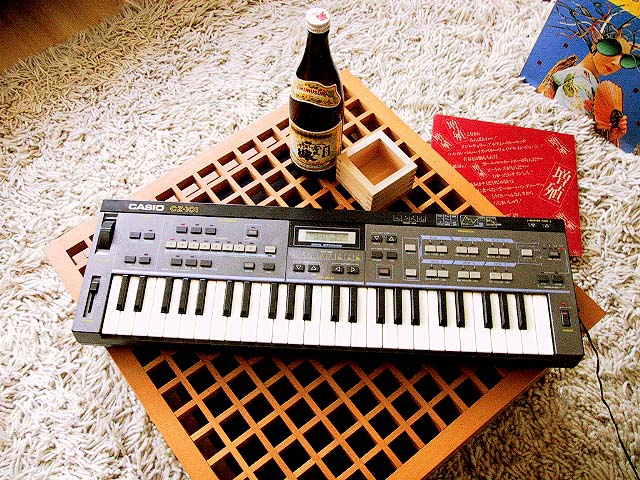
• The CZ101 is probably the best known and most appreciated synth
in the CZ series by connoisseurs. She’s the little sister of the CZ1000
(which is exactly the same, only bigger) and was designed to compete with
the Yamaha DX series, but even within the CZ series she has her own unique
charm. Her exotic synthesis was named ‘Phase Distortion’ by
those geniuses of anything miniature at Casio, and is not much unlike FM
synthesis: where FM alters the Frequency Modulation, Phase Distortion alters
the phase (shape) of the waveform. It uses six 8-stage envelopes, three
for each of the two oscs: one for the DCO (pitch envelope), a DCW envelope
which is comparable with a filter envelope and is responsible for the sound,
and an 8 stage DCA envelope, where A stands for Amplifier.
Further more she offers a maximum of 8 voice polyphony (or 4 if you use
both oscs), it has limited modulation (only Vibrato can be programmed) and
there’s no mod wheel. She does have a very nice portamento and she
even has noise and / or ring modulation, which is best used to create her
infamous metallic sounds.
The sound is good and has a distinctive edge, you might recognise it in
some of the early detroit techno and chicago house records, as wel as in
mid 80’s synthpop. Playing around with the two oscs and their several
envelopes will get you quite amazing sounds, sounds that are hard to recreate
on your average subtractive synthesizer, digital or analogue. Ofcourse she
does sound digital and perhaps even slightly thin or metallic compared to
the analogue synths you might wanna try to emulate, but that’s exactly
the lovely charm of the CZ101. So, if you get hooked to the CZ101, you will
be very happy to know she is 4 parts multi-timbral! Sound-wise, the comparison
with FM synthesizers is easily made, and although the Yamaha DX and Casio
CZ series were competitors in the mid 80s affordable-digital-synth race
(Casio lost) they really do complement eachother.
For more info about the CZ-101 and all other Casio synthesizers I advice you check out Cosmo's Casio World.
A very dedicated site by a very dedicated CZ fan that's well worth a visit!
Sound example: 2 x Casio CZ 101 (both playing the same bass sound) and Roland TR707 (sequenced with RS7000)
Casio CZ 1
• The
CZ1 is a new occurence of the Casio CZ virus that never seems to get
completely elliminated at the Sternstudio. Most important benefits of
the CZ1 above the CZ101's is that it has more user patches, chorus,
velocity, aftertouch, mod wheel, 4 modulation types, glide and you can
set the output levels for the 2 DCA's seperatly. Technically it can be
16 voices, but since that requires only 1 of the oscs it will most of
the time be limited to 8 voices. The CZ101 is 4 part multitimbral, the
CZ1 8 part but it wants you to assign a number of voices for each part
and as said; the CZ1 is most of the time limited to 8 voices. Still
better then the CZ101 so let's not complain. It can do sysex dumps
(hurray!!!) and you can exchange sounds with your CZ101. So how does it
sound? Pretty much the same.The chorus is a nice but noisy addition.
Perhaps it's a little bit warmer but that can only be caused by the
outputs, the CZ101 and CZ1 use technically the same engines.
Cirko Hound *
• Probably the most obscure synth in my small collection, and
the most troublesome sofar, but fortunatly the troubles have been solved.
Build by a Dutch company, the Hound was intended to forfill the producers
need of an advanced hybrid synthesizer: 4 stable DCO’s, 3 lfo’s,
voltage controlled filter (with an extra function called ‘fatness’,
invented by Cirko), 3 env’s and 4 outputs... this machine rocks, editing
is done with 6 knobs, a dial and a screen on front of this 2HU rack synthesizer....
Editing is rather rather easy, but the interface doesn't make it the live
machine I hoped it to be. I think only 17 are build sofar.
Note: I sold
it... despite it was a nice synth and not that hard to edit at all, the
sound didn't fit my expectations. I did use it on the TBH album, but after
that I figured it didn't fit into my set-up. If you ever encounter one and
need info, feel free tocontact me, I have complete back ups of the Cirko
website and the operation manual that might give you an idea of what this
synth can do for you.
Clavia Nord Rack
• Another Rack Synth is this first Clavia attampt to make a
decent
Virtual Analogue synthesizer. Needless to say, this machine is a
modern
classic, inspired by the SCI Prophet 5 (even the presets are clearly
intended to clone the P5 ). I don't know whether Clavia succeeded
there, but they did came up with a workhorse that is able to come quite
close to some of the budget analog and digital synths I own. Because
it's a bit of a chameleon it's been my favored live-synth for almost 10
years. But don't expect really big sounds from it, it sure won't mimic
the classic analogs 100%. Unless you treat it with some analog effects
and filters it's just not strong enough and it will always keep that
typical Nord digital edge. Especially in the higher octave ranges it
never really convinces.
It's a great synth for starters and once you collected a few more
desired (analog-)synths it just might become the tool that will give
room for those classic synths to take care of parts that really matter.
I wouldn't get rid of it, perhaps if I ever get the desire to buy a
slightly more versatile (4 outputs, 16 voices and some other extra
feautures) Nord Lead 2 I might get rid of it.
Korg DW 8000
• Analoge filters and 16 sampled waveforms... this is an old Korg
flagship. Altho I liked to think of it as the black sheep in my studio,
I use it more and more. Its sounds are truly great, a welcome variation
to the Yamaha DX synthesizers and a nice adition to the Casio CZ.
Sound example: Korg DW8000 bass (sequenced with RS7000)
Korg 707
• Backed up by investments from Yamaha, Korg made this weird FM
synth available in four different colors, using Yamaha 4 operator FM
technology and sound chip taken from the Yamaha FB-01 and Korg DS-08
(which looks more like the DW8000, the 707 looks more like the M1). But
whilst the DS-08 used dual oscilators, the 707 uses only one (and
doesn't have the on-board effects the DS-08 has). It does have it's own
sound, rather thin and dinky but still quite fun. Somehow I really don't
like editing it, even tweaking the presets is no fun at all. But to be
honest, I haven't spend much time trying to figure this synth out. Right
now I'm not bored (nor ashamed) using the 707's presets, maybe when I
do get bored I might get motivated to dive into this synth. But right
now I couldn't care less.
LEM Bit 99
• Successor of the famous Italian Crumar Bit 99. Designed by none
other than Mario Maggi (the man responsible for the Elka Synthex and coproducer
of that beautiful Automat album) with dual oscillators, dual contour generators,
and bonuses such as full MIDI implementation, velocity sensitivity, unison,
splits and bi-timbrality, it compared favourably to more expensive instruments.
Sound example: Bit 99 bassline, JX8p bassline and DR660 drums accompany the Nord Rack strings and DW8000 woodwind-like sound
Roland Juno 60 (with JSQ60 and MD-8)
• Richer, better, nicer, more reliable compared to the 106.
The
Juno 60 is a beauty, no doubt. The Juno 60 made me realize
that it's about time I'd get rid of all those silly budget analogs and
start upgrading to the real thing...
The JSQ60 kinda sucks, but it came with the juno 60 so I won't
complain. I did get me a Roland MD-8 midi -> DCB interface, to have
some midi control (note on and of ;) ) over my Juno60. Working with the
arp triggered by a tr-707 was really workable, but it's a shame to use
this lovely synth only monophonic. I got the MD-8 for a nice price, but
there are better interfaces around. Nice thing however about the MD-8
above other interfaces is that it works two ways: you can also set it to
DCB -> midi.
Roland Juno 106
• Classic Roland synth. Gotta have one to love one, it does make
a great synthesizer for anyone starting out with analog synths. It is the
kind of synth that will never leave your studio, no matter how packed that
studio becomes over the years.
Soundexample: Roland Juno 106 bassline, Casio CZ-1 string, TR707 and 727 percussion, sequenced with Renoise
Roland JX8P
• What's there to say? Great synth!.
12 Oscs, 2 DCO's per voice
makes this a trusty a6 voice analog synth. Great for those classic
Roland strings and basses that everybody seems to be looking for,
this synth will not leave the studio for a while.
Sound example: jx8p strings, juno 60 bass and tr707 and 727 percussion (sequenced with Octamed)
Spectral Audio ProTone *
• Nice Roland SH101 like synth. Fully analogue with 2 VCO’s,
mid -> CV, ring modulator, slides and accents (like the 303, indeed)
and external VCF input make this synthesizer a nice machine. Note: I sold
this because I never used it. It doesn't mean a thing that I sold it, it
is quite a good synthesizer if you can get it for 225 euro's MAX.
Siel DK 80
• Nice italian made analoge machine, looks like some sort of Korg
Poly800 clone. Nothing special, but since they are cheap it's always a good
buy, no doubt. There is this whistling kinda sound in the lower ranges,
but I never cared too much about that. Low budget is not a choice you make,
so you better do with what you have.
I used it a lot on 'The Eye That Never Sleeps', and it was an important
synth for that track called 'The Plot', of which you can find an excerpt
on the mp3 page.
Yamaha DX 100
• Another little classic machine. If I remeber correctly, it was
much used together with the Casio CZ 101 by various artists from the past.
Easier to edit then the DX 7 and it does sound slightly different, a bit
more metallic. A great synth to have around. It was the first synthesizer
I ever bought.
Sound example: Siel DK80, Yamaha DX100, Yamaha SU10 sampler (sampled 808 kit), MAM vocoder.
Yamaha TX 7
• Module of the DX7. This synth was designed to be hooked up to- and edited
with your DX 7, there's no other way to it. Ofcourse a DX 7 editor will get you a long way, but why
not get both? They're cheap and you'll have full FM power coming out of
your speakers... owwwwwwwww... That will keep you happy for a long time!
Yamaha DX 7
• Go Get One! You'll see I'm right when I say there's no way to
start talking about his lovely synth. This synth is why Brian Eno got rid
of all his analogs at a certain point in time. Okay, maybe he was overdoing
it a bit, but still it does indicate what this synth is capable of. It was
and it remains a revolutionairy synth.
x0xb0x
• Supposedly the best sounding 303 emulator as it is completely reverse engineered. Maybe that's so, maybe not. I personally find it very convinsing, really good enough to suit my needs. And the sequencer alone was worth adding it to my set up.
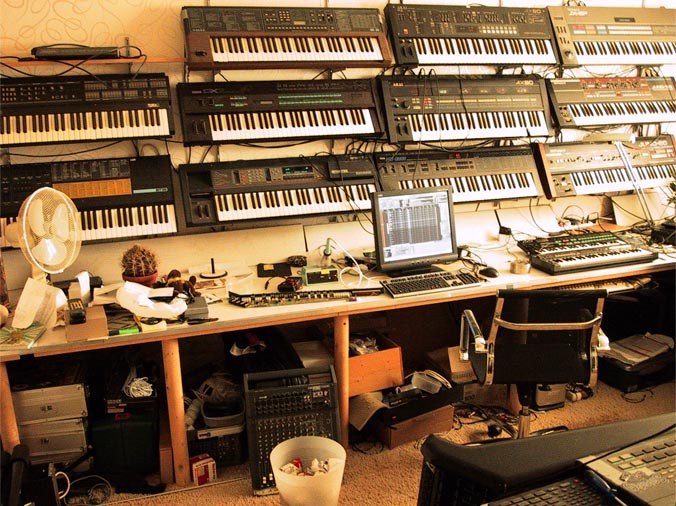
Drums and samplers:
Casio
RZ-1
•
Work that mother fucker. Very distinct sound and rather unreliable
but that makes it so great. Stay away from programming cliché rhtythms
on this one, it's a weird machine so better use it for weird drumtracks.
Perhaps not the best example, but still an example: RZ-1, DX-7, Juno 60, Ensoniq EPS (Sequenced with Octamed)
Roland TR 505
Roland TR 707 / TR 727
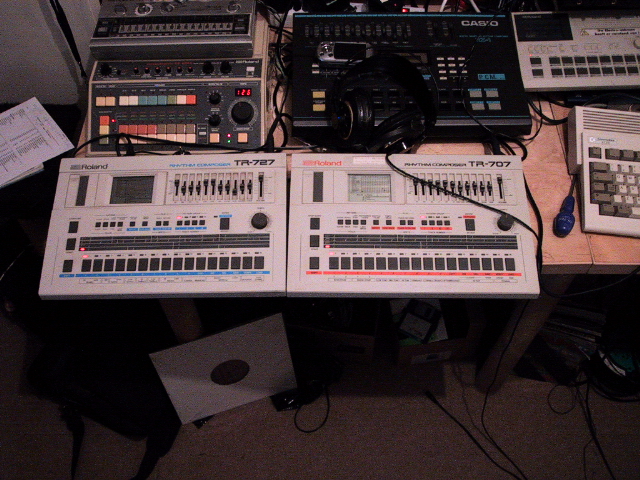
• Forget about the 909. The Roland TR707 and 727 are the ultimate
Chicago House drum machines. 64 patterns, 998 bars, step edit whilst you
play the sequence, a nice big display that shows you the entire pattern
in one single view (note: it is a shame it has no backlight), trigger output,
din-sync in/out, midi (-sync) in and out, shuffle and flam... All in all,
more than enough to satisfy your drum-sequencing needs. The 707’s
15 drum sounds are too cool to ignore. Nice and punchy bassdrums and snaredrums
and a set of gritty hi-hats, funky rides and ear crushing crash cymbals…
The samples in this budget machine rock beyond believe. Add the 727 to your
707 and you’ll be jacking it latino style like Mario ‘Smoking’
Diaz or playing it as smooth as Mr. Fingers with 15 more percussion sounds.
Better get a big mixer if you are one of those control freaks; almost every
sound has it’s own individual output… But then again…
why bother? The volume sliders for each sound give you enough control, so
you might as well use the stereo output. But hey, atleast you have a choice!
Boss DR 660
• The little machine that you will instantly recognize
in a lot of them Dance Mania records. A Roger Linn design that will take
you to ghetto paradise.
Sound example: Akai AX60, Boss DR660, Akai S2000 sampler.
Boss DR 770
Kawai R100 (thanks Niels!)
Ensoniq EPS 8 outs
Akai S2000 8 outs
Amiga 1200
Yamaha RS-7000
• At start it's a bit hard to grasp all it's functions,
but once you get into this machine it will prove to be a very good live
sequencer. It has pretty bad but fun internal sounds and a quite good
sampler, which are nice bonusses. The biggest benefit of this machine is
without a single doubt it's very versatile and hands on sequencer. Of
course it has it's quircks, but non of them are bad enough to not even
considder this as a replacement for your laptop running Ableton.
Sequencing & computer power:
Roland
JSQ-60
Amiga 1200 running Octamed
iMac running Renoise
MacBook Pro
Modified Emagic EMI 2-6 soundcard (2x)
Midisport 2x4
Various VST plug-ins
Outboard, mixing, recording:
Zoom
effects
Yamaha effects
Various guitar effect pedals
Aria mixer with spring reverb
Spirit mixer (used only in live set)
D&R 900 16-8-2 mixer (given away for spare parts)
D&R Dayner 36-8-2 + 8 tape returns
• The
D&R Dayner, the latest acquisition of the Sternstudio's, is a
modular mixer build and designed in Holland in the late 80's till early
90's.
The D&R Dayner came in five 'chassis frames' sizes, holding
either 21, 31 42, 59 or 84 modules (and you could choose between either a
desktop frame or a 'studio' frame). There were 4 different types of
modules to choose from: line channel, split channel, a patchbay and a
tape return module with 4 tape returns, and ofcourse you had the
extensive master module with 8 aux sends (which takes the room of 3
modules and can be placed anywhere in the frame).
The most beautiful feature of this (and some other-) D&R's is
the 'floating subgroup' system, which allows you to have the 8 subgroups
where you want them instead of on a fixed place on the board, and it
also allows you to have as many summed outputs as you need, limited only
by the number of input modules in your frame. There where two types of
channel modules. A line module with line input, mic input, channel
insert, group insert and tape send, effectively 5 aux sends (where aux
3,4, 5 are switchable to aux 6,7,8), phase, phantom, six segment LED
bar, a semi paramteric EQ, ALP fader and the floating subgroup system.
The other type of module was the split module, which could be split into
2, allowing you to have equalization on both inputs, on the same
channel, at the same time. During it's lifespan, D&R revised the
Dayner atleast once. Old modules have the old square looking DR logo
(without the & ), newer modules have a new logo (with the &
imposed on the D and the R).
The mixer is extremely quiet. In comparence to my old D&R 900,
the Dayner isn't noisy at all and has lots of headroom. It's not as
woolly sounding, more transparant, but still with a certain character.
Perhaps it won't do much good in a modern pro-studio, but considering
todays prices, I think the Dayner is definitely favourable above the
typical home stiudio mxers such as Behringers and Mackies.
If you want to buy one, there's some things you should know. If
you encounter one with humming or a crackling sound, either the ribbon
cables that connect the different modules are screwed up, or there's
something wrong with the PSU (the 59 and 84 chassis systems require two
PSU's).
As far as I can tell there is no audible difference between the
old line modules wit the old logo and the revised ones, nor is there a
difference between the build of these line modules, except in the ribbon
cables. Still it is advisable to find the newer modules with the new
logo rather then the old ones. Even if there's no technical difference
at all (which I'm not sure of), there is still the difference in age.
Speaking of age: if you buy one, always considder the fact that is
an old console; there's always something that should be replaced or
cleaned and redoing the solder joints is something you'll do often and a
lot of parts like pots are absolete. If you don't want to spend some
time with a soldering iron once in a while, better search for something
new.
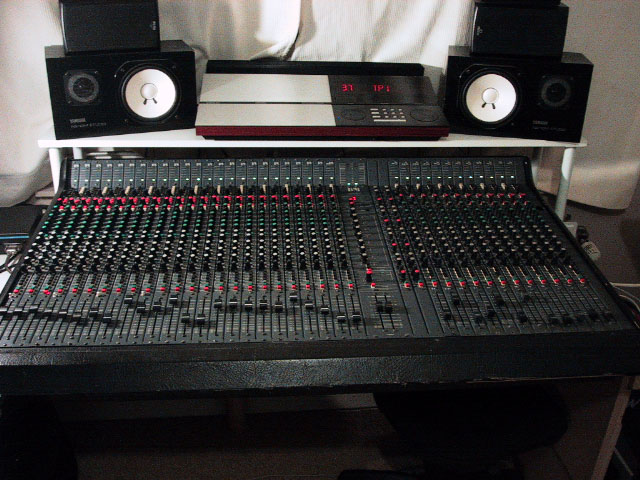
D&R Dayner 14-8-2
This D&R Dayner is in a 31 chassis frame and in good working condition, but is meant to be used for spare parts.
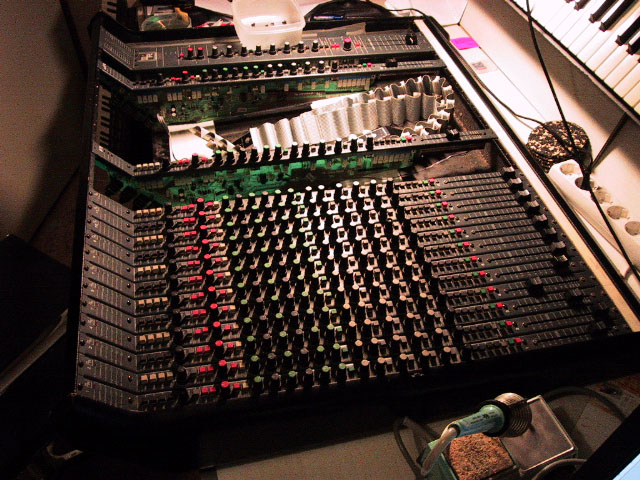
D&R parametric EQ
D&R compressors
D&R noise gate
Spl Vitalizer
Behringer patchbay
Yamaha NS 10 monitors
Bose speakers
Mission speakers
Magnat speakers
Philips computer speakers
JBL computer speakers
Bang & Olufsen Beomaster 8000 amp
Rotel amp
Kenwood amp
AKG headphones
Sony portable DAT recorder
NAD cassette recorder
Phillips CD-R audio recorder
Bang & Olufsen Beogram 8002 recordplayer with MMC2
NAD CD player
Philips N7150 4 track reel to reel recorder
Teac 'Tascam Series' 32-2 2 track reel to reel recorder + remote
• In essence, this is simply a different looking Teac X10m. Except for the looks there's only one major difference: this Tascam can only record at 7,5 ips and 15 ips, which makes it more suitable for the studio than the X10m. You can find this recorder labeled as the Tascam 32-2 as well, cause apparently Teac didn't change it's studio brandname into Tascam for all markets.
There was also the Teac Tascam Series 32-2B, which isn't much different from the 32-2 except for it's layout, and it has record mode buttons for the left channel and right channel rather then just one record mode button for both channels.
A 7" reel version was also build, called the 22-2. Don't confuse any of these with the Tascam 32 and 32B, those are different recorders alltogether (first thing that you can notice from a mile away is that the Tascam 32 has only one pinchroller).
And to make matters even more confusing: the Tascam 32 was sold as the Teac Tascam Series 33-2...
Revox PR99mkIII 2 track reel to reel recorder + remote
• Again, a semi pro recorder based on a consumer model. But unlike the Teac where the difference in speed is really makes a sonic difference, the PR99 is not much different to the 2 Track High Speed B77 (B77HS). If Teac Tascam made things confusing, Revox made things incomprehensible. Of the B77 more than 60 versions where available for a wide range of purposes. The PR99mkIII was focused on the semi pro market and was mostly used for broadcasting and editing, as the tape is much easier to reach than on the regular B77. It has balanced connectors and (except for the MKI model) the PR99 has a more sophisticated transport controls with for instance loop function, location memory / zero return and tape dump. Apperently in the early 1990s the PR99 has been available as the Studer PR99. That's not completely surprising, as the mkIII version followed the mkII only to fit the looks of the new Studer line (A810, A820, etc) together with the then newly introduced Revox C270 series.
